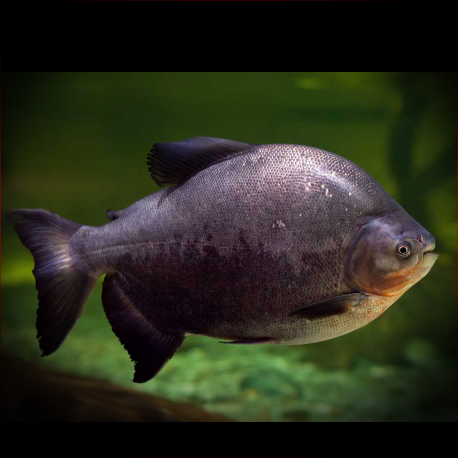More info
Datasheet
| Minimum Tank Size | 2500 litres / 660.43 US gallons |
| Maximum Size | 100.0cm / 39.37inches |
| Temperature | 22°C / 71.60°F - 28°C / 82.40°F |
| Hardness | 1-15ºdH |
| pH | 5.5-7.5 |
General Description
Known as the tambaqui in its native countries, the Black Pacu is the second-largest scaled fish species in the Amazon basin, capable of growing up to about two feet in length. With a resemblance to the piranha, the pacu is a herbivorous species that also feeds on insects, zooplankton, and small fish. It possesses impressive dentition ideal for crushing fruits, nuts, and seeds, with teeth similar to human molars and powerful jaws.
Aquarium Setup
For housing a Black Pacu, a vast tank of at least 2500 liters with strong filtration is essential. Decor is not crucial due to the fish's high activity level, but heavy, immovable items like boulders, driftwood, or beech branches can be added. Plants are likely to be consumed and should be avoided. A large and efficient biological filter is necessary to manage waste production, with the option of a sump-type system. Regular significant water changes are vital to maintain water quality.
Behaviour
Black Pacu is generally peaceful with larger species but may eat smaller fish. As juveniles, they are shoaling, but they become more solitary as they mature. Inadequate space can lead to adult pacus becoming aggressive, chasing and nipping at other fish. Suitable tankmates in a spacious environment include Arowana, big characins, large cichlids, and catfish from specific groups like Pimelodid and Loricariid.
Feeding and Diet
Their diet primarily consists of fruits, nuts, and seeds in the wild, and a captive pacu should be offered a varied diet. Quality dried pellets, fruits, and vegetables like spinach, lettuce, apple, banana, peach, and others are suitable options. Being opportunistic, they may also consume insects and zooplankton.
Reproduction & Dimorphism
Reproduction of Black Pacu is not commonly achieved in aquarium settings but is conducted for commercial purposes using hormonal induction. Mature females are slightly rounder-bellied compared to males.
Habitat and Distribution
Inhabiting main river channels and flood plains in the Amazon and Rio Orinoco basins, Black Pacu prefers shallow, slow-moving waters with vegetation. They move to flooded forests during the rainy season. Native to South America, specifically Colombia, Venezuela, Peru, Bolivia, and Brazil, introduced populations can be found in various countries globally, including the West Indies and Taiwan.

